Wistron NeWeb DRCM Part 15 Spread Spectrum Module (802.11 B/G) User Manual integrators manual
Wistron NeWeb Corporation Part 15 Spread Spectrum Module (802.11 B/G) integrators manual
Contents
- 1. integrators manual
- 2. User Manual
integrators manual
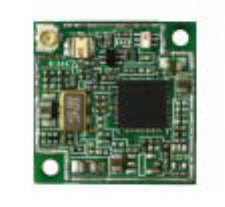
WLAN 802.11 b/g Embedded Module
User Manual
(DRCM-81)
Version: 1.0
Nov. 2005
1
Copyright Statement
No part of this publication may be reproduced, stored in a retrieval system, or
transmitted in any form or by any means, whether electronic, mechanical,
photocopying, recording or otherwise without the prior writing of the publisher.
Windows™ 98SE/2000/ME/XP are trademarks of Microsoft® Corp.
Pentium is trademark of Intel.
All copyright reserved.

2
Contents
FEDERAL COMMUNICATION COMMISSION INTERFERENCE STATEMENT.3
FOR OEM INTEGRATORS..........................................................................................4
HARDWARE INSTALLATION & ANTENNA INFORMATION...............................5
1. INTRODUCTION .....................................................................................................8
1.1 THE WLAN 802.11G...............................................................................................8
1.2 FEATURES ................................................................................................................8
2. PLANNING YOUR WIRELESS NETWORK .........................................................9
2.1 WLAN.....................................................................................................................9
2.2 AD-HOC AND INFRASTRUCTURE .............................................................................9
3. SOFTWARE INSTALLATION AND UNINSTALLATION...................................11
3.1 SETUP WIZARD INSTALLATION .............................................................................11
3.2 ADDITIONAL SETUP PROCESSES............................................................................15
3.3 UNINSTALLATION...................................................................................................16
4. USING IEEE802.11G WLAN UTILITY................................................................17
4.1 OVERVIEW .............................................................................................................17
4.2 ACCESSING THE CONFIGURATION UTILITY..........................................................17
4.3 LINK STATUS..........................................................................................................18
4.4 CONFIGURE PROFILE ............................................................................................19
4.5 SITE SURVEY..........................................................................................................23
APPENDIX A: GLOSSARY .......................................................................................24

3
Federal Communication Commission Interference Statement
This equipment has been tested and found to comply with the limits for a Class B
digital device, pursuant to Part 15 of the FCC Rules. These limits are designed to
provide reasonable protection against harmful interference in a residential installation.
This equipment generates, uses and can radiate radio frequency energy and, if not
installed and used in accordance with the instructions, may cause harmful interference
to radio communications. However, there is no guarantee that interference will not
occur in a particular installation. If this equipment does cause harmful interference to
radio or television reception, which can be determined by turning the equipment off
and on, the user is encouraged to try to correct the interference by one of the
following measures:
- Reorient or relocate the receiving antenna.
- Increase the separation between the equipment and receiver.
- Connect the equipment into an outlet on a circuit different from that to which the
receiver is connected.
- Consult the dealer or an experienced radio/TV technician for help.
This device complies with Part 15 of the FCC Rules. Operation is subject to the
following two conditions:
(1) This device may not cause harmful interference, and
(2) This device must accept any interference received, including interference that
may cause undesired operation.
Information
To assure continued compliance, (example - use only shielded interface cables when
connecting to computer or peripheral devices) any changes or modifications not
expressly approved by the party responsible for compliance could void the user’s
authority to operate this equipment.
IMPORTANT NOTE:
FCC Radiation Exposure Statement:
This equipment complies with FCC radiation exposure limits set forth for an
uncontrolled environment. This equipment should be installed and operated with
minimum distance 20cm between the radiator & your body.
This transmitter must not be co-located or operating in conjunction with any other
antenna or transmitter.

4
For OEM integrators
This device is intended only for OEM integrators under the following conditions:
1) The antenna must be installed such that 20 cm is maintained between the antenna
and users, and
2) The transmitter module may not be co-located with any other transmitter or
antenna.
As long as the 2 conditions above are met, further transmitter testing will not be
required. However, the OEM integrator is still responsible for testing their
end-product for any additional compliance requirements required with this module
installed (for example, digital device emissions, PC peripheral requirements, etc.).
IMPORTANT NOTE: In the event that these conditions can not be met (for
example certain laptop configurations or co-location with another transmitter), then
the FCC authorization is no longer considered valid and the FCC ID can not be used
on the final product. In these circumstances, the OEM integrator will be responsible
for re-evaluating the end product (including the transmitter) and obtaining a separate
FCC authorization.
End Product Labeling
This transmitter module is authorized only for use in devices where the antenna may
be installed such that 20 cm may be maintained between the antenna and users (for
example Notebook PC, access points, routers, wireless ASDL modems, and similar
equipment). The final end product must be labeled in a visible area with the
following: "Contains TX FCC ID: NKRDRCM".
Manual Information That Must be Included
The users manual for end users must include the following information in a prominent
location "IMPORTANT NOTE: To comply with FCC RF exposure compliance
requirements, the antenna used for this transmitter must be installed to provide a
separation distance of at least 20 cm from all persons and must not be co-located or
operating in conjunction with any other antenna or transmitter."
Additional Information That Must be Provided to OEM Integrators
The end user should NOT be provided any instructions on how to remove or install
the device.
The module is for OEM installation only and can not be sold to end user directly.
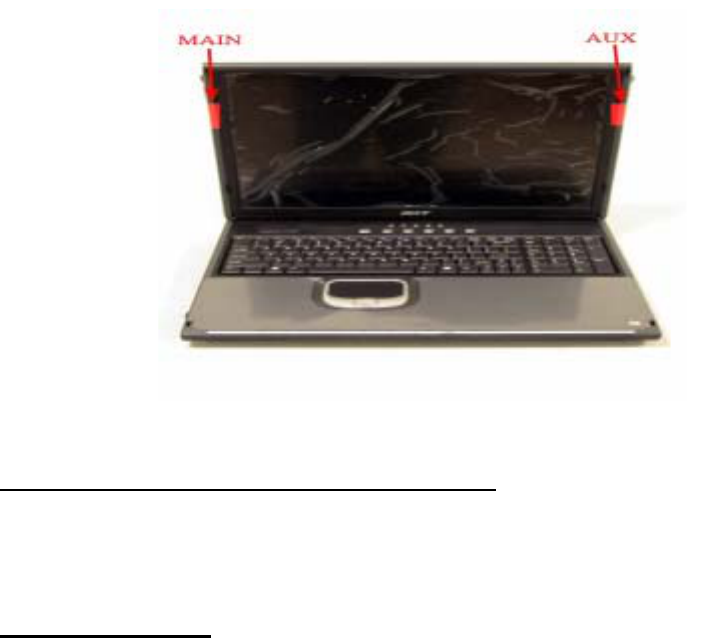
5
Hardware Installation & Antenna Information
Module is installed in the Personal Computer, located on the bottom side of
the Personal Computer.
Antennas are embedded in the two sides (see the two antennas shown
below)
Only the antenna types listed below can be used:
Antenna 1: Dipole (Model: F1B-204406-52, made by Long-Chu Co.)
Antenna 2: Dipole (model: C478-510028-A, made by Wha Yu Co.)
Important Note:
This module is restricted to mobile configuration. The antennas of module should be
installed and operated with minimum distance 20cm between the radiator and all
persons. This transmitter must not be co-located or operating in conjunction with any
other antenna or transmitter.
The end user should NOT be provided any instructions on how to remove or install
the device.
The module is for OEM installation only and can not be sold to end user directly.

6
*Caution !!
(1). This module cannot be bound in a tablet computer for RF exposure issues.
(See label 1)
(2). Due to the RF exposure issues, this module can be used in a laptop computer
in normal operation, but cannot be used when it is put above the lap and the
LCD screen is in the closed position. (See label 2)
Label 1 Label 2
The device can’t be operated above
the lap when the LCD is closed
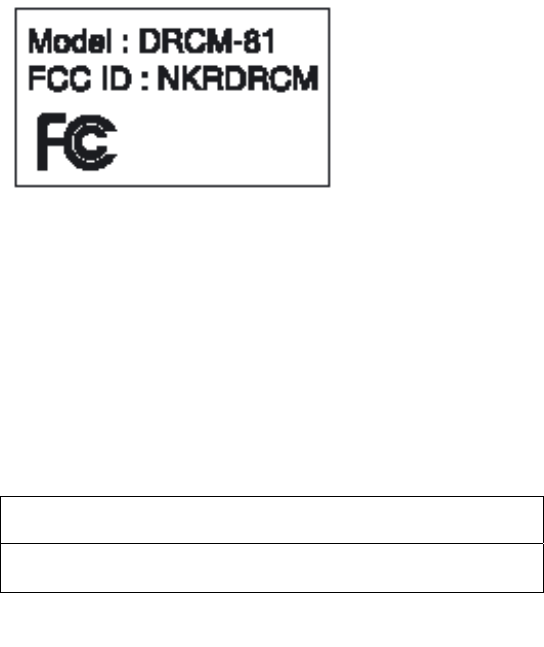
7
(3). This module must be labeled with FCC ID. (See label 3)
(4). If the FCC ID is not visible when the module is installed inside another
device, then the outside of device must also display a label referring to the
enclosed module. The exterior label can be
“ Contains Transmitter Module FCC ID:NKRDRCM ” or similar wording. (See
label 4)
Contains Transmitter Module DRCM-81
FCC ID: NKRDRCM
Please put Label 3 & Label 4 to the enclosure of end product to note the end user.
Label 3
Label 4

8
1. Introduction
1.1 The WLAN 802.11g
802.11g is a 54Mbps wireless networking standard that's almost five times faster than
the widely deployed 802.11b products found in homes, businesses, and public
wireless hotspots. Because both 802.11b and 802.11g share the same 2.4GHz radio
band, 802.11g devices can also work with existing 11Mbps 802.11b equipment.
Once connected to a wireless network, you can keep in touch with your e-mail, access
the Internet, and share files and other resources such as printers and network storage
with other computers on the network, wherever you wander. At home, you can surf
the web or use instant messaging to chat with friends while sitting out on the patio.
You'll also be able to connect with any of the growing number of public wireless
hotspots springing up in coffee shops, airport lounges, hotels and convention centers.
And as those hotspots upgrade to the new high-speed 802.11g standard, you'll be
ready to take advantage of the increased speeds. Get connected to current-standard
802.11b networks today, and be prepared for the future with the 802.11g miniPCI.
1.2 Features
CF Interface
Dimensions: 20 x 20 x 3.5mm
Driver Supporting:
Linux Driver Source Code & Porting Guide
WinCE v4.2 & 5.0 DLL I/F
WLAN Plug-in Modules for Non-Wireless Systems
Supports Contention Free (CF)-poll and CF-ACK for Operation under Point
Coordination Function(PCF)
Supports Request to Send(RTS) / Clear to Send(CTS) for Operation under
Distribution Coordination Function(DCF)
54Mbps high-speed wireless transfer rate
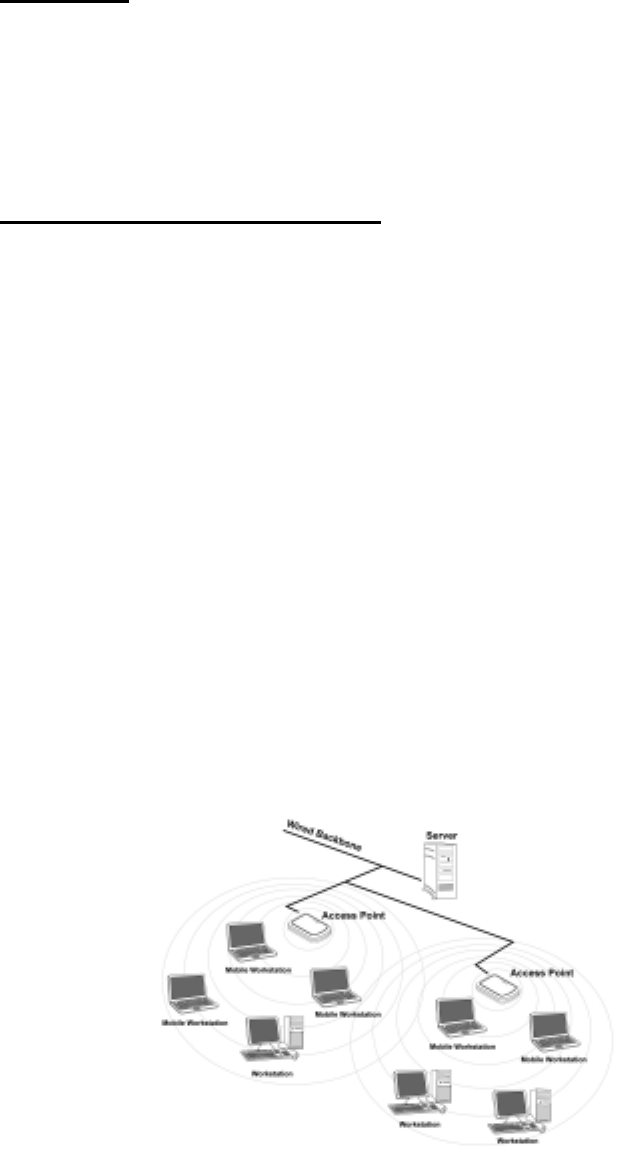
9
2. Planning Your Wireless Network
2.1 WLAN
A wireless local area network (WLAN) is exactly like a regular local area network
(LAN), except that each computer in the WLAN uses a wireless device to connect to
the network. Computers in a WLAN share the same frequency channel and SSID,
which is an identification name for wireless devices.
2.2 Ad-Hoc and Infrastructure
Unlike wired networks, wireless networks have two different modes: Ad-Hoc and
Infrastructure. An Ad-Hoc configuration is wireless-equipped computers
communicating directly with each other. An infrastructure configuration is a WLAN
and wired LAN communicating to each other through an access point. Choosing
between these two modes depends on whether or not the wireless network needs to
share data or peripherals with a wired network.
If the computers on the wireless network need to be accessed by a wired network or
need to share a peripheral, such as a printer, with the wired network computers, the
wireless network should be set up in Infrastructure mode. (See Figure 2-1.) The
basis of infrastructure mode centers around an access point, which serves as the main
point of communications in a wireless network. Access points transmit data to PCs
equipped with wireless network devices, which can roam within a certain radial range
of the access point. Multiple access points can be arranged to work in succession to
extend the roaming range, and can be set up to communicate with your Ethernet
(wired) hardware as well.
Figure 2-1
If the wireless network is relatively small and needs to share resources only with the
other computers on the wireless network, then the Ad-Hoc mode can be used. (See
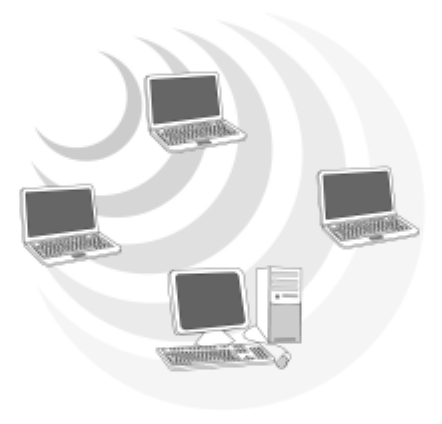
10
Figure 2-2.) Ad-Hoc mode allows computers equipped with wireless transmitters and
receivers to communicate directly with each other, eliminating the need for an access
point. The drawback of this mode is that, in Ad- Hoc mode, wireless-equipped
computers are not able to communicate with computers on a wired network.
Figure 2-2
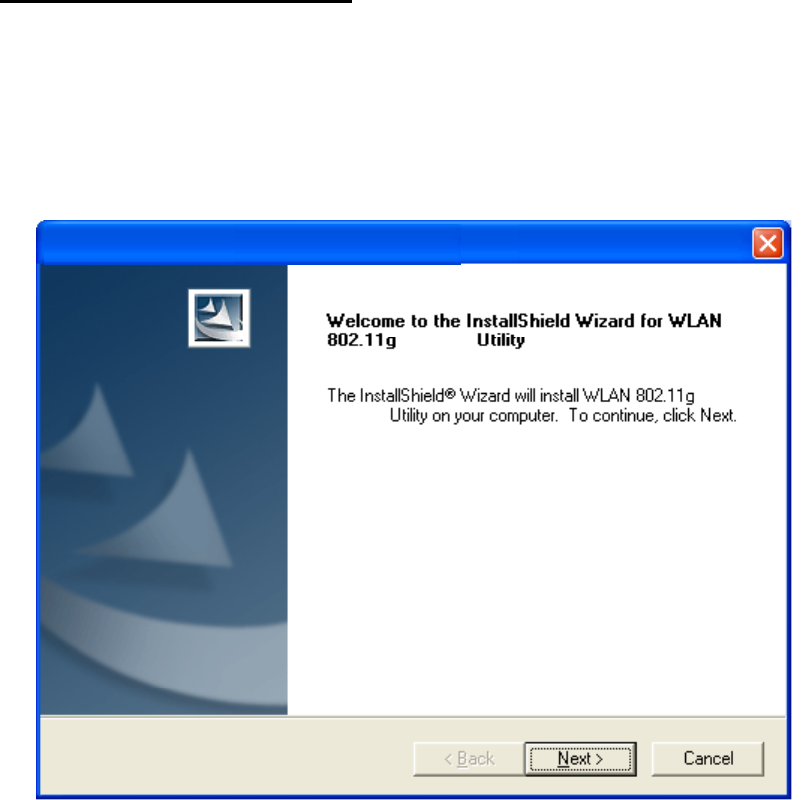
11
3. Software Installation and Uninstallation
Note! The Installation Section in this Manual describes the first-time installation for
Windows. To re-install the driver, please first uninstall the previously installed
driver. See Chapter “3.4 Uninstallation” in this Manual.
3.1 Setup Wizard Installation
Follow the steps below to complete the driver/utility installation:
1. Insert the Installation Software CD into the CD-Rom Drive.
2. Click “Next” button.
WLAN 802.11g miniPCI Setup
miniPCI
miniPCI
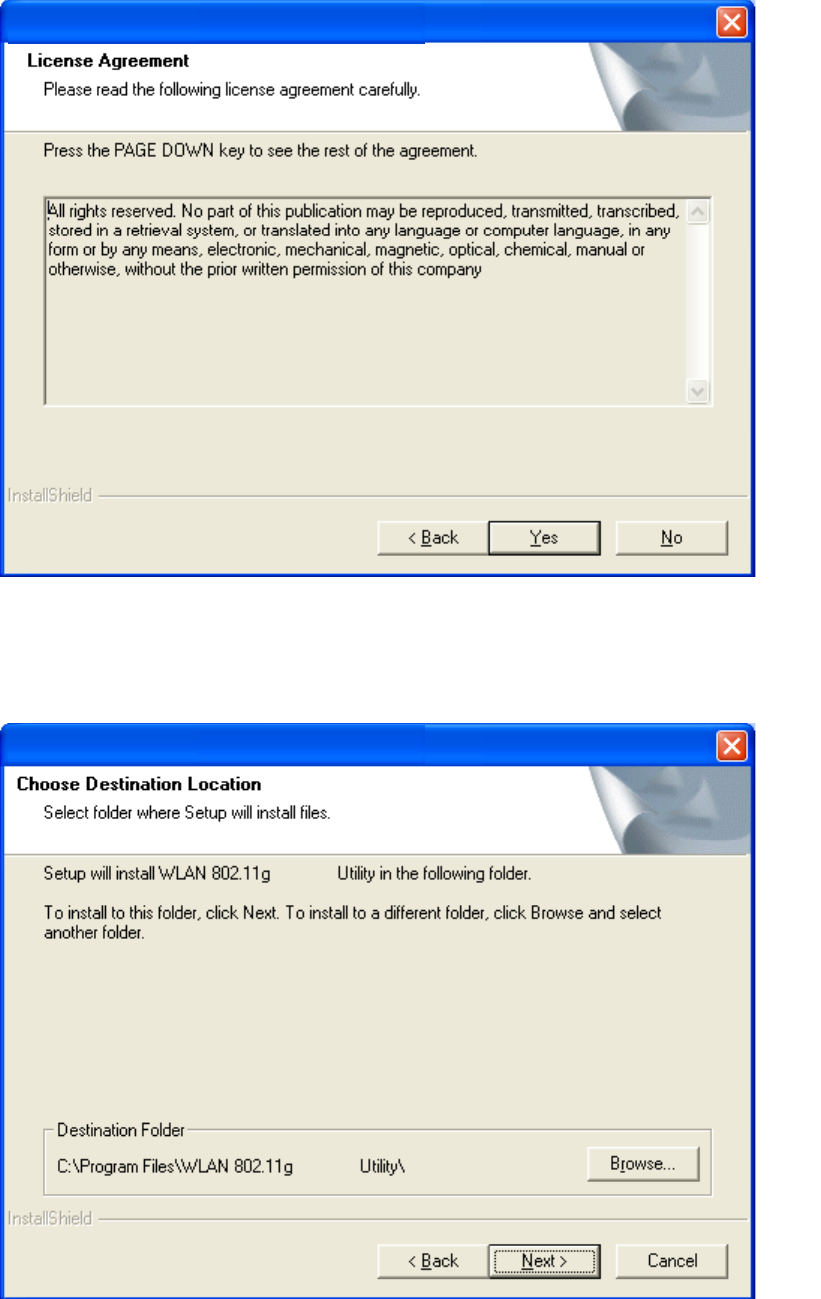
12
3. Read the License Agreement and click “Yes” button.
WLAN 802.11g miniPCI Setup
4. Click “Next” button to continue or click “Browse” button to choose a destination
folder.
miniPCI
miniPCI
WLAN 802.11g miniPCI Setup
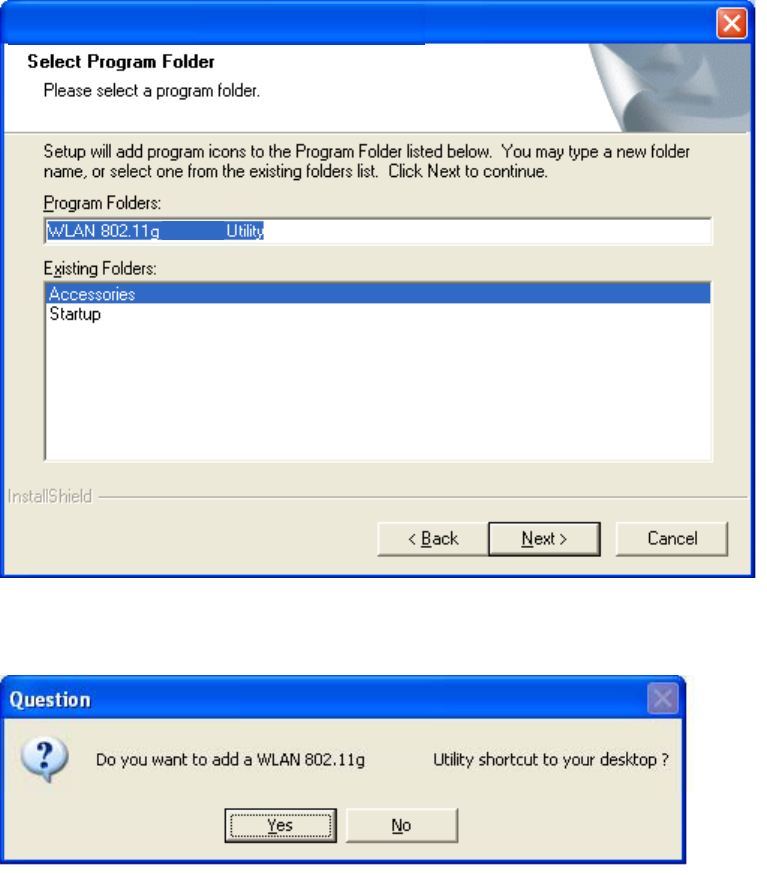
13
5. Click “Next” button.
miniPCI
WLAN 802.11g miniPCI Setup
6. Click “Yes” button.
miniPCI
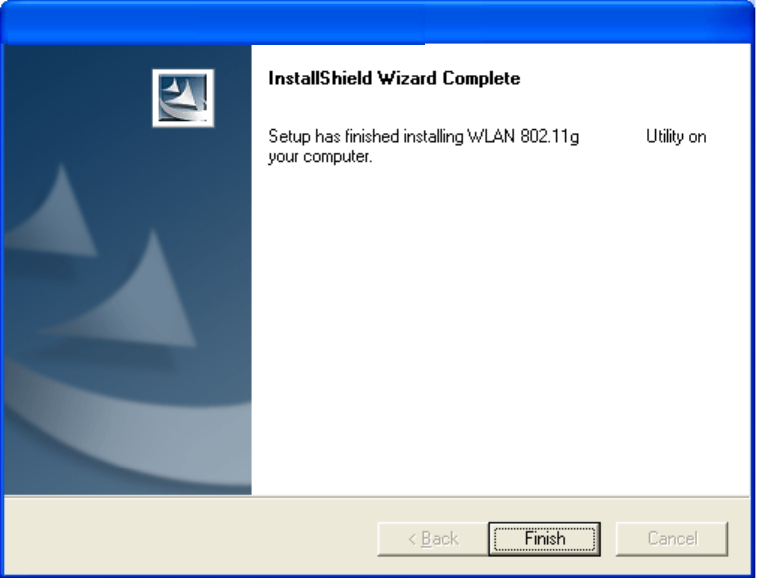
14
7. Click “Finish” button. Restart your computer if necessary.
miniPCI
WLAN 802.11g miniPCI Setup
8. You may now see the WLAN 802.11g Utility shortcut icon on the desktop.

15
3.2 Additional Setup Processes
During software installation procedure, each operating system may prompt different
specific options. Mostly, you will be asked to add some necessary protocols and to
edit some networking settings. Please contact the network administrator for details.
1. Windows 98SE: The system may request the original Windows CD during the
installation process. When the installation is finished, you’ll have to restart your
computer.
2. Windows Me: Please restart your computer when the installation is finished.
3. Windows 2000/XP: Select “Install the software automatically” when the window
with this option appears, and then click “Next” button to continue installation.

16
3.3 Uninstallation
Note! Before uninstallation, please close all running programs.
1. Click Start>Programs>WLAN 802.11g miniPCI Utility>UnInstall WLAN
802.11g miniPCI.
2. Choose “Remove-Remove all installed features” and click “Next” button.
3. Click “OK” button to reconfirm.
4. Click “Finish” and restart your computer to complete Uninstallation steps.

17
4. Using IEEE802.11g WLAN Utility
4.1 Overview
Use IEEE802.11g WLAN Utility to search for available wireless networks, connect to
wireless network, or check the link status.
4.2 Accessing the Configuration Utility
1. After software installation, the WLAN 802.11g Utility icon will appear on your
desktop. Double click the icon.
2. The WLAN 802.11g Utility will appear and automatically link with the available
network that has the best signal strength and is not WEP encrypted.
If all the available network (Access Point) is WEP encrypted, please contact with
the network administrator for the WEP setting.
Note: Once connected, the link-status icon will become green .
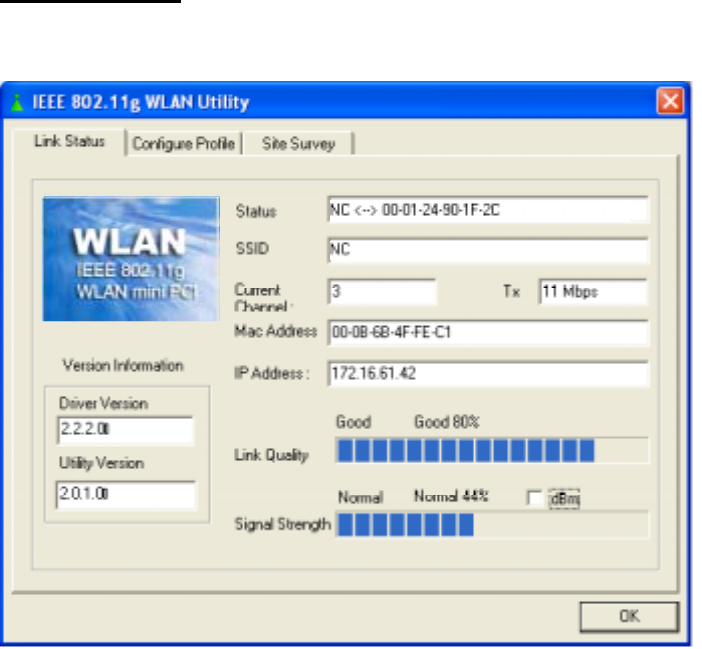
18
4.3 Link Status
The Link Status tab shows the link status, including SSID, channel, Mac Address, IP
address, Link Quality and Signal Strength.
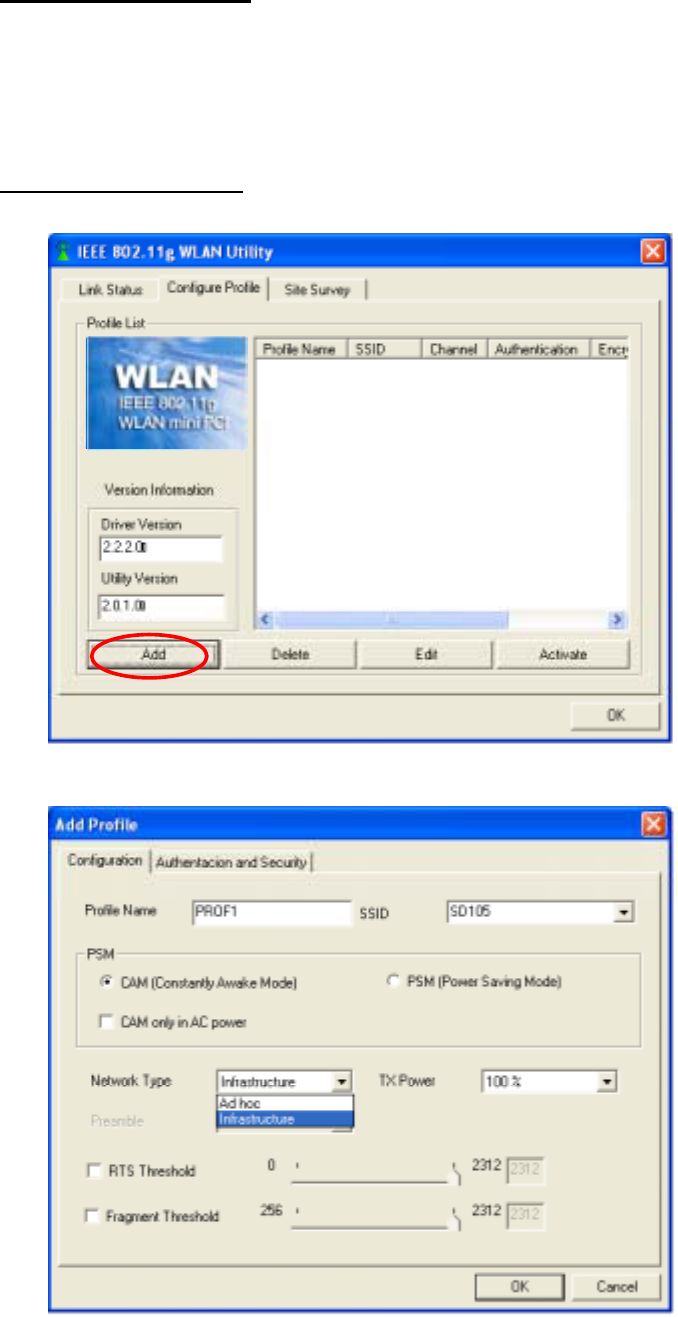
19
4.4 Configure Profile
The Configure Profile tab is for you to create and configure the profile (Network) that
you frequently use to link per your requirement. The profile records the system
Configuration, Authentication and Security.
4.4.1 To create a profile
1. Click “Add” button.
2. Add Profile window pops up. Enter a Profile Name and choose a SSID.
3. In Configuration tab, please choose CAM (Constantly Awake Mode) for
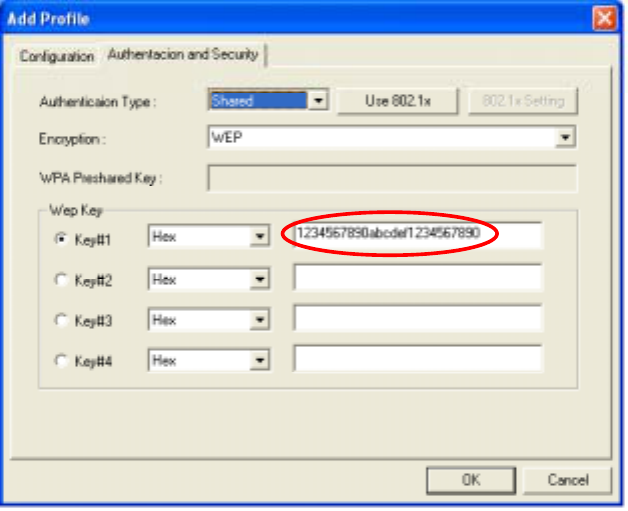
20
Infrastructure Network Type. For 802.11 Ad Hoc Network Type, please
activate PSM (Power Saving Mode).
4. In Authentication & Security tab, please contact the network administrator for
WEP Key setting if the chosen AP (SSID) is WEP encrypted.
Authentication Type
Four options are available: None, Shared, WPA and WPA-PSK.
802.1x
If choose to use 802.1x, please click “802.1x Setting” button to open 802.1x
Setting window. Contact the network administrator for the value of each
setting.
Wep Key
Four Wep Keys are available. Each key can be set as Hex or ASCII.
Contact the network administrator for the values of settings.
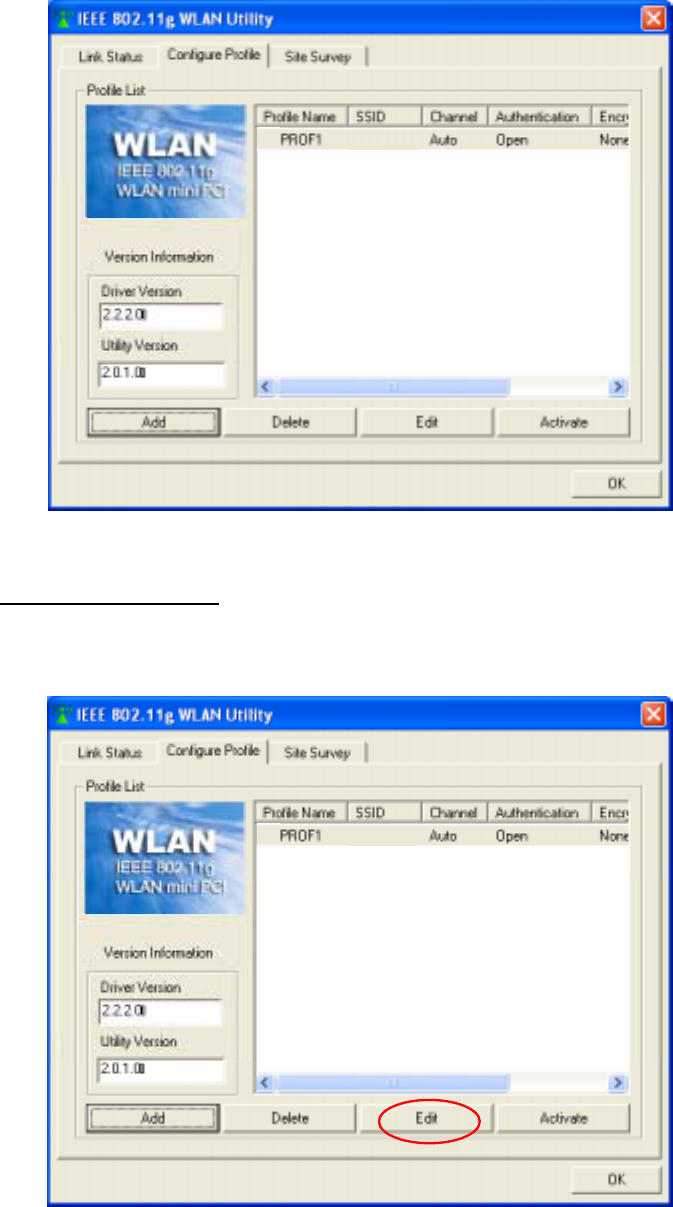
21
5. Click “OK”. The newly created profile is now listed in Configure Profile tab.
SD105
4.4.2 To edit a profile
1. In Configure Profile tab, choose the profile (by clicking the profile name from
the list) and then click “Edit” button.
SD105
2. Add Profile window pops up. Edit the settings in Configuration tab and
Authentication & Security tab. Click “OK” button to save the new settings.

22
4.4.3 To delete a profile
1. In Configure Profile tab, choose the profile (by clicking the profile name from
the list).
2. Click “Delete” button.
4.4.4 To activate a profile
1. In Configure Profile tab, choose the profile (by clicking the profile name from
the list).
2. Click “Activate” button.
3. An activate icon will appear in front of the profile name. Green icon
indicates connected, and red one indicates disconnected.
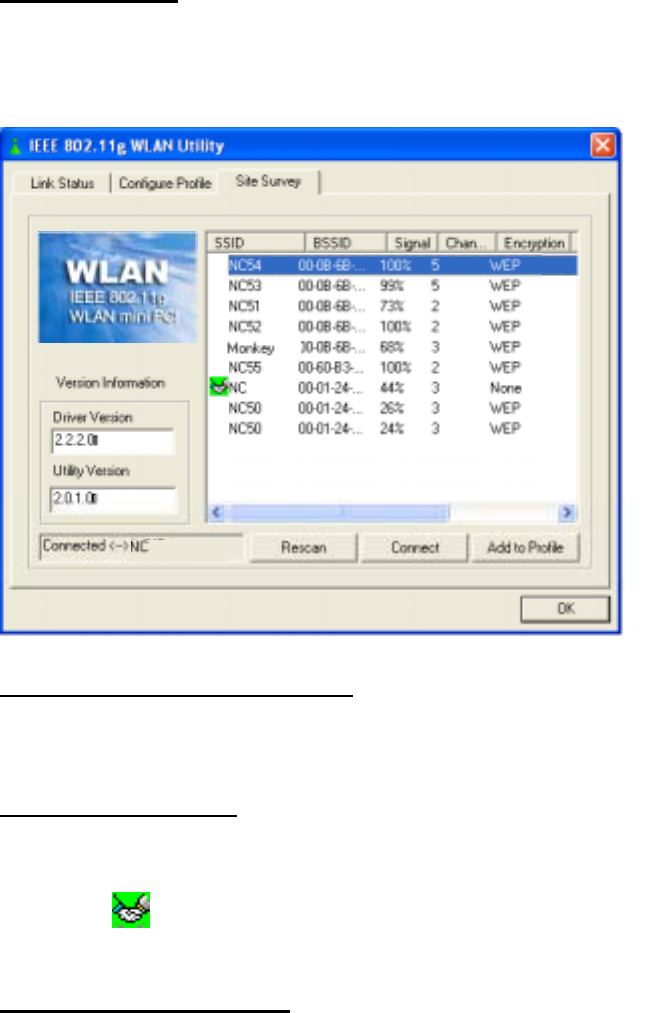
23
4.5 Site Survey
This tab gives you the information of all the available networks in vicinity, such as
SSID, BSSID, Signal, Channel, Encryption, Authentication and Network Type, so that
you can select a network with better signal for better performance.
4.5.1 To rescan available networks
Click “Rescan” button to find all available networks in vicinity.
4.5.2 To join a network
1. Choose a network (by clicking the SSID from the list).
2. Click “Connect” button.
3. An icon , indicates connected, will appear in front of the SSID.
4.5.3 To create a new profile
1. Choose a network (by clicking the SSID from the list).
2. Click “Add to Profile” button.
3. Add Profile window pops up. Edit the settings in Configuration and
Authentication & Security tabs, and then click “OK” button.
24
Appendix A: Glossary
802.11b – One of the IEEE standards of wireless networking hardware. Products that
adhere to a specific IEEE standard will work with each other, even if they are
manufactured by different companies. The 802.11b standard specifies a maximum
data transfer rate of 11Mbps, an operating frequency of 2.4GHz, and WEP encryption
for security. 802.11b networks are also referred to as Wi-Fi networks.
802.11g – Refers to the proposed extension of the IEEE 802.11 standard for wireless
networking, which has not been ratified by IEEE. The 802.11g specifications specify
a maximum data transfer rate of 54Mbps using OFDM modulation, an operating
frequency of 2.4GHz, backward compatibility with IEEE 802.11b devices and WEP
encryption for security.
Ad-Hoc Network - An Ad-Hoc network is a group of computers, each with a wireless
adapter, connected as an independent 802.11 wireless LAN. Ad-Hoc wireless
computers operate on a peer-to-peer basis, communicating directly with each other
without the use of an access point. Ad-Hoc mode is also referred to as an Independent
Basic Service Set (IBSS) or as peer-to-peer mode, and is useful at a departmental
scale or SOHO operation.
CTS (Clear To Send) – An RS-232 signal sent from the receiving station to the
transmitting station that indicates it is ready to accept data.
Default Gateway - The router used to forward all traffic that is not addressed to a
station within the local subnet.
DHCP (Dynamic Host Configuration Protocol)- A protocol that lets network
administrators manage centrally and automate the assignment of Internet Protocol (IP)
addresses in an organization’s network. Using the Internet’s set of protocol (TCP/IP),
each machine that can connect to the Internet needs a unique IP address. When an
organization sets up its computer users with a connection to the Internet, an IP address
must be assigned to each machine. Without DHCP, the IP address must be entered
manually at each computer and, if computers move to another location in another part
of the network, new IP address must be entered. DHCP lets a network administrator
supervise and distribute IP address from a central point and automatically sends a new
IP address when a computer is plugged into a different place in the network.
25
DHCP uses the concept of a “lease” or amount of time that a given IP address will be
valid for a computer. The lease time can vary depending on how long a user is likely
to require the Internet connection at a particular location. It’s especially useful in
education and other environments where users change frequently. Using very short
lease, DHCP can dynamically reconfigure networks in which there are more
computers than there are available IP address.
DHCP supports static addresses for computers containing Web servers that need a
permanent IP address.
DNS – The domain name system (DNS) is the way that Internet domain name are
located and translated into Internet Protocol (IP) addresses. A domain name is a
meaningful and easy-to-remember “handle” for an Internet address.
DSSS (Direct-Sequence Spread Spectrum) – DSSS generates a redundant bit pattern
for all transmitted data. This bit pattern is called a chip (or chipping code). Even if
one or more bits in the chip are damaged during transmission, statistical techniques
embedded in the receiver can recover the original data without the need for
retransmission. To an unintended receiver, DSSS appears as low power wideband
noise and is rejected(ignored) by most narrowband receivers. However, to an intended
receiver (i.e. another wireless LAN endpoint), the DSSS signal is recognized as the
only valid signal, and interference is inherently rejected (ignored).
Dynamic IP Address – An IP address that is automatically assigned to a client station
in a TCP/IP network, typically by a DHCP server. Network devices that serve multiple
users, such as servers and printers, are usually assigned static IP addresses.
ESS (Extended Service Set) – A set of more than two or more BSSs (multiple access
points) forming a single network.
Firmware – Code that is written onto read-only memory (ROM) or programmable
read-only memory (PROM). Once firmware has been written onto the ROM or
PROM, it is retained even when the device is turned off.
IEEE – The Institute of Electrical and Electronics Engineers. The IEEE describes
itself as “the world’s largest technical professional society – promoting the
development and application of electro-technology and allied sciences for the benefit
of humanity, the advancement of the profession, and the well-being of our members.”
The IEEE fosters the development of standards that often become national and
26
international standards. The organization publishes a number of journals, has many
local chapters, and several large societies in special areas, such as the IEEE Computer
Society.
Infrastructure Network – An Infrastructure network is a group of computers or other
devices, each with a wireless adapter, connected as an 802.11 wireless LAN. In
infrastructure mode, the wireless devices communicate with each other and to a wired
network by first going through an access point. An infrastructure wireless network
connected to a wired network is referred to as a Basic Service Set (BSS). A set of two
or more BSS in a single network is referred to as an Extended Service Set(ESS).
Infrastructure mode is useful at a corporation scale, or when it is necessary to connect
the wired and wireless networks.
IP Address – In the most widely installed level of the Internet Protocol(IP) today, an
IP address is a 32 – binary digit number that identifies each sender or receiver of
information that is sent in packet across the Internet. When you request an HTML
page or send e-mail, the Internet Protocol part of TCP/IP includes your IP address in
the message ( actually, in each of the packets if more than one is required) and sends it
to the IP address that is obtained by looking up the domain name in the Uniform
Resource Locator you requested or in the e-mail address you’re sending a note to. At
the other end, the recipient can see the IP address of the Web page requester or the
e-mail sender and can respond by sending another message using the IP address it
received.
IPCONFIG – A utility that provides for querying, defining and managing IP
addresses within a network. A commonly used utility, under Windows NT and 2000,
for configuring networks with static IP addresses.
ISP – An ISP (Internet service provider) is a company that provides individuals and
companies access to the Internet and other related services such as Web site building
and virtual hosting.
LAN – A local area network (LAN) is a group of computers and associated devices
that share a common communications line and typically share the resource of a single
processor or server within a small geographic area ( for example, within an office
building).
MAC Address – The MAC (Media Access Control) address is your computer’s
27
unique hardware number.
mIRC – mIRC runs under Windows and provides a graphical interface for logging
onto IRC servers and listing, joining and leaving channels.
Network Mask – also known as the “Subnet Mask”.
OFDM – Developed for wireless applications, Orthogonal Frequency Division
Multiplexing (OFDM) technology offers superior performance-increased data rates
and more reliable transmissions- than previous technologies, such as DSSS. OFDM is
a scheme in which numerous signals of different frequencies are combined to form a
single signal for transmission on the medium. OFDM works by breaking one
high-speed data stream into a number of lower-speed data streams, which are than
transmitted in parallel. Each lower speed stream is used to modulate a sub-carrier.
Essentially, this creates a multi-carrier transmission by dividing a wide frequency
band or channel into a number of narrower frequency bands or sub-channels. OFDM
is also used for other applications, including power line networking.
Roaming - In an infrastructure mode wireless network, this refers to the ability to
move out of one access point's range and into another and transparently reassociate
and reauthenticate to the new access point. This reassociation and reauthentication
should occur without user intervention and ideally without interruption to network
connectivity. A typical scenario would be a location with multiple access points,
where users can physically relocate from one area to another and easily maintain
connectivity.
SSID (Service Set Identifier) - An identification name that wireless devices use to
make connections. In order for wireless devices to communicate, they must all be set
to the same channel and they all must use the same SSID. For instance, if you are
using an access point to connect two computers using wireless devices, the access
point and each of the wireless devices must use the same SSID. Even if they are set to
the same channel, they cannot communicate unless the SSID is the same.
Static IP Address - A permanent IP address that is assigned to a node in a TCP/IP
network.
Subnet Mask - The method used for splitting IP networks into a series of subgroups,
28
or subnets. The mask is a binary pattern that is matched up with the IP address to turn
part of the host ID address field into a field for subnets.
TCP (Transmission Control Protocol) - A method (protocol) used along with the IP
(Internet Protocol) to send data in the form of message units (data gram) between
network devices over a LAN or WAN. While IP takes care of handling the actual
delivery of the data (routing), TCP takes care of keeping track of the individual units
of data (called packets) that a message is divided into for efficient delivery over the
network. TCP is known as a "connection oriented" protocol due to requiring the
receiver of a packet to return an acknowledgment of receipt to the sender of the
packet resulting in transmission control.
TCP/IP (Transmission Control Protocol/Internet Protocol) - The basic
communication language or set of protocols for communications over a network
(developed specifically for the Internet). TCP/IP defines a suite or group of protocols
and not only TCP and IP.
UDP (User Datagram Protocol) - A method (protocol) used along with the IP
(Internet Protocol) to send data in the form of message units (datagram) between
network devices over a LAN or WAN. While IP takes care of handling the actual
delivery of the data (routing), UDP takes care of keeping track of the individual units
of data (called packets) that a message is divided into for efficient delivery over the
network. UDP is known as a “connection-less” protocol due to NOT requiring the
receiver of a packet to return an acknowledgment of receipt to the sender of the
packet (as opposed to TCP). WEP (Wired Equivalent Privacy) - A data privacy
mechanism based on a 64- bit shared key algorithm, as described in the IEEE 802.11b
standard. WINIPCFG - Configuration utility based on the Win32 API for querying,
defining and managing IP addresses within a network. A commonly used utility under
Windows 95, 98SE, and Me.
WLAN (Wireless Local Area Network) - A group of computers and associated
devices that communicate with each other wirelessly.